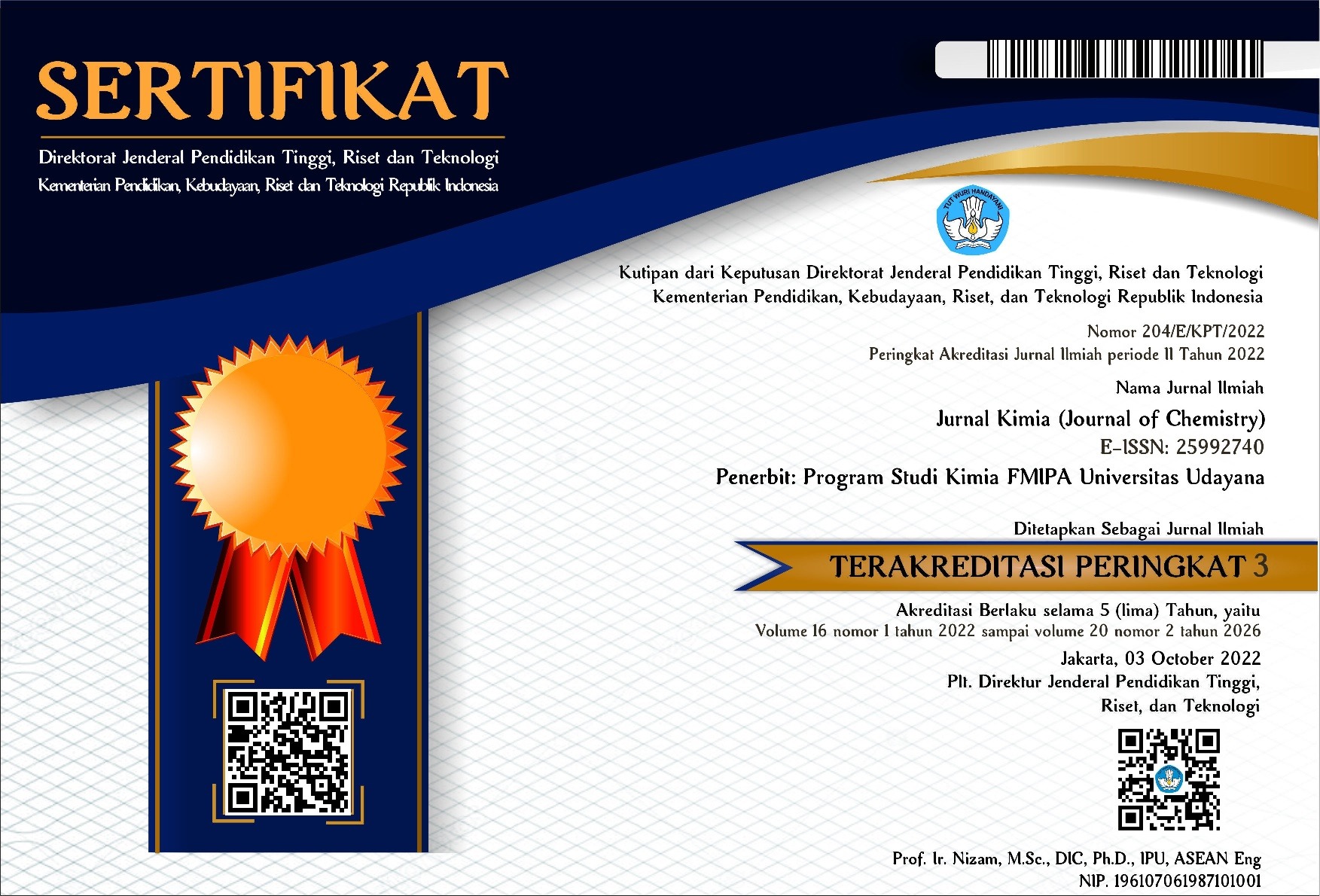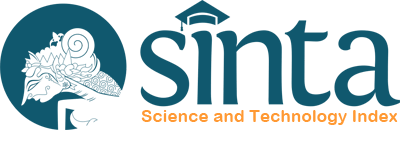SINTESIS DAN ELUSIDASI STRUKTUR SENYAWA ANALOG KURKUMIN SIMETRIS DARI BAHAN DASAR 3,4-DIMETOKSIBENZALDEHIDA DAN KETON (SIKLOHEKSANON DAN SIKLOPENTANON) DENGAN KATALIS KALIUM HIDROKSIDA
Abstract
Sintesis analog kurkumin simetris dari bahan dasar 3,4-dimetoksibenzaldehida dan keton (sikloheksanon dan siklopentanon) telah dilakukan. Senyawa A (2,6-bis(3,4-dimetoksibenzilidin)sikloheksanon) dan B (2,6-bis(3,4-dimetoksibenzilidin)siklopentanon) disintesis menggunakan reaksi kondensasi Claisen-Schmidt dari bahan dasar turunan benzaldehida dan keton, katalis kalium hidroksida (KOH) 8% dan pelarut etanol. Hasil penelitian menunjukkan bahwa senyawa analog kurkumin simetris A dan B berupa serbuk kuning dan orange dengan rendemen sebesar 26,39% dan 18,42%. Reaksi pada sintesis senyawa analog kurkumin A dan B dimonitor dengan plat Thin Layer Chromatography (TLC) menggunakan eluen etil asetat dan n-heksana. Titik leleh senyawa A berada pada interval 140-146 °C dan senyawa B berada pada interval 186-189 °C. Kemudian elusidasi struktur dilakukan menggunakan Fourier Transform Infra Red (FT-IR), Direct Inlet Mass Spectrometry (DI-MS), Proton Nuclear Magnetic Resonance (1H-NMR) dan Carbon-13 Nuclear Magnetic Resonance (13C-NMR). Spektra FT-IR senyawa A dan B menunjukkan adanya vibrasi dari gugus fungsi Csp3-H, C=O karbonil, C=C aromatis dan C-O eter. Berdasarkan analisis DI-MS senyawa A dan B menunjukkan berat molekul berturut-turut 394 g/mol dan 380 g/mol. Spektra 1H-NMR dan 13C-NMR pada analog kurkumin simetris A dan B menunjukkan adanya H? dan karbon yang mengikat H?. Berdasarkan hasil elusidasi struktur menunjukkan bahwa senyawa analog kurkumin simetris A (2,6-bis(3,4-dimetoksibenzilidin)sikloheksanon) dan analog kurkumin simetris B (2,6-bis(3,4-dimetoksibenzilidin)siklopentanon) berhasil disintesis.
Kata kunci: sintesis, elusidasi, analog kurkumin, 3,4-dimetoksibenzaldehida
ABSTRACT
The synthesis of symmetric curcumin analogues from 3,4-dimethoxybenzaldehyde and ketones (cyclohexanone and cyclopentanone) has been carried out. The compounds A (2,6-bis(3,4-dimethoxybenzylidine)cyclohexanone) and B (2,6-bis(3,4-dimethoxybenzylidine)cyclopentanone) were synthesized using the Claisen-Schmidt condensation reaction of benzaldehyde derivatives and ketone, potassium hydroxide catalyst (KOH) 8% and ethanol solvent. The results showed that the powder of symmetric curcumin analogue compounds A and B were yellow with yields of 26.39% and 18.42%, respectively. The synthesis reactions of curcumin analogue compounds A and B were monitored by Thin Layer Chromatography (TLC) plates using ethyl acetate and n-hexane as eluents. The melting point of compound A was in the interval of 140-146 °C, and compound B was in the interval 186-189 °C. The structure elucidation was carried out using Fourier Transform Infrared (FTIR), Direct Inlet Mass Spectrometry (DI-MS), Proton Nuclear Magnetic Resonance (1H-NMR), and Carbon-13 Nuclear Magnetic Resonance (13C-NMR). The FTIR spectra of compounds A and B showed the vibrations of the Csp3-H, C=O carbonyl, C=C aromatic, and C-O ether functional groups. Based on the DI-MS analysis, compounds A and B had molecular weights of 394 g/mol and 380 g/mol, respectively. The 1H-NMR and 13C-NMR spectra of symmetric curcumin analogues A and B showed the presence of H? and H?-binding carbon. Based on the results of the structure elucidation, the symmetrical curcumin analog compound A (2,6-bis(3,4-dimethoxybenzylidine)cyclohexanone) and the symmetrical curcumin analog B (2,6-bis(3,4-dimethoxybenzylidine)cyclopentanone) were successfully synthesized.
Keywords: synthesis, elucidation, curcumin analogs, 3,4-dimethoxybenzaldehyde
Downloads
References
Anand, P., Thomas, S.G., Kunnumakkara, A.B., Sundaram, C., Harikumar, K.B., Sung, B., Tharakan, S.T., Misra, K., Priyadarsini, I.K., Rajasekharan, K.N., Aggarwal, B.B. 2008. Biological Activities of Curcumin and its Analogues (Congeners) Made by Man and Mother Nature. Biochem Pharmacol. 76(11): 1590–1611.
Du, Z., Liu, R., Shao, W., Mao, X., Ma, L., Gu, L., Huang, Z., Chan, A.S.C. 2006. Alpha-Glukosidase Inhibition of Natural Curcuminoids and Curcumin Analogs. Eur. J. Med. Chem. 41(2): 213-218.
Hawaiz, F.E., Omer, D.A.S. 2017. Ultrasound-assisted Synthesis of Some New Curcumin Analogues and Their Corresponding Pyrazoline Derivatives. ARO-The Scientific Journal of Koya University. 5(1): 30–35.
Ji, H.F., Shen, L. 2009. Interaction of Curcumin with The PfATP6 Model and The Implications for Its Antimalarial Mechanism. Bioorg. Med. Chem. Lett. 19(9): 2453-2455.
Liang, G., Shao, L., Wang, Y., Zhao, C., Chu, Y., Xiao, J., Zhao, Y., Li, X., Yang, S. 2009. Exploration and Synthesis of Curcumin Analogues with Improved Structural Stability Both in Vitro and in Vivo as Cytotoxic Agents. Bioorg. Med. Chem. 17(6): 2623–2631.
Li, Q., Chen, J., Luo, S., Xu, J., Huang, Q., Liu, T. 2015. Synthesis and Assessment of The Antioxidant and Antitumor Properties of Asymmetric Curcumin Analogues. Eur. J. Med. Chem. 93: 461–469.
Najafian, M. 2015. The Effects of Curcumin on Alpha Amylase in Diabetic Rats. Zahedan J. Res. Med. Sci. 17(12): 5198-5206.
Nelson, K.M., Dahlin, J.L., Bisson, J., Graham, J., Pauli, G.F., Walters, M.A. 2017. The Essential Medicinal Chemistry of Curcumin. J. Med. Chem. 69: 1620-1627.
Patil, C.B., Mahajan, S.K., Katti, S.A. 2009. Chalcone: A Versatile Molecule. J. Pharm. Sci. Res. 1(3): 11-22.
Ramya, P.V.S., Guntuku, L., Angapelly, S., Karri, S., Digwal, C.S., Babu, B.N., Naidu, V.G.M., Kamal, A. 2018. Curcumin Inspired 2-Chloro/Phenoxy Quinoline Analogues: Synthesis and Biological Evaluation as Potential Anticancer Agents. Bioorg. Med. Chem. Lett. 28: 892-898.
Wang, Z.S., Chen, L.Z., Zhou, H.P., Liu, X.H., Chen, F.H. 2017. Diarylpentadienone Derivatives (Curcumin Analogues): Synthesis and Anti-Inflammatory Activity. Bioorg. Med. Chem. Lett. 27(8): 1803–1807.
Yao, E.C., Xue, L. 2014. Therapeutic Effects of Curcumin on Alzheimer’s Disease. Adv. In Alzheimer’s Disease. 3(4):145-159.
Yin, S., Zheng, X., Yao, X., Wang, Y., Liao, D. 2013. Synthesis and Anticancer Activity of Mono-carbonyl Analogues of Curcumin. J. Cancer Ther. 4(1): 113-123.
Yuan, X., Li, H., Bai, H., Su, Z., Xiang, Q., Wang, C., Zhai, B., Zhang, Y., Zhang, Q., Chu, Y., Huang, Y. 2014. Synthesis of Novel Curcumin Analogues for Inhibition of 11β-Hydroxysteroid Dehydrogenase Type 1 with Anti-diabetic Properties. Eur. J. Med. Chem. 77:223–230.

This work is licensed under a Creative Commons Attribution 4.0 International License





